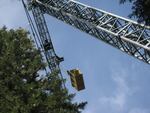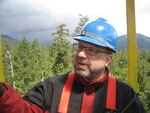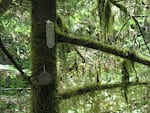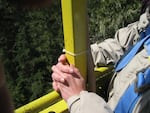
The crane's boom and gondola will be removed this summer. The forest service is leaving the tower up and will continue to use the instruments on it to gather data on climate change
Amelia Templeton
Fifteen years ago, scientists set up a 25 story yellow construction crane, the same machine that builds high-rises, in a pristine old growth forest about an hour from Portland.
The crane, located in the Wind River Experimental forest, has allowed scientists in the Pacific Northwest to explore a kind of last frontier: the high canopy of a Douglas Fir and Mountain Hemlock forest. The trees in Oregon and Washington are among the tallest anywhere in the world.
University of Washington scientist Matt Schrader works at the Wind River Research Station. He says scientists have used their special vantage point here to learn what kind of lichen birds chose when building nests, and how trees manage to pump water hundreds of feet up to their highest branches.
“Some of the most detailed pictures of photosynthesis were constructed here in this forest by this crane by having access to all the tips of these different branches,” he says.
The Wind River Canopy crane is one of just eleven in the world, and the only crane in a coniferous, temperate forest.
This crane helped researchers learn that old growth forests aren't just slowly rotting; they're still growing and sucking carbon dioxide out of the air. That finding overturned a long-held belief that old-growth forests were either carbon neutral or sources of carbon. When the leaves and needles in this forest photosynthesize, they breathe in more carbon dioxide than everything in the forest put together breathes out.
Instruments on the 230-foot crane tower measure wind speed and analyze the mixture of gases coming off the forest. During the day, the trees breathe in carbon dioxide. At night, they release it.
Scientist and arbonaut Ken Bible helps me and a few other reporters into safety harnesses. Herding us into the crane's gondola, he sounds a bit like a Ferris wheel operator.
“Everybody gets a window seat so please turn around and enjoy the ride up," he says. "Why don’t we get on board.”
The trees blur and the crane hums and we’re lifting up… and up… and up. Bible explains how the structure of the forest changes as we rise:
“In less than a minute, we changed to a completely different environment, from one that’s controlled by the cool, dark understory to one that’s controlled by the hot, dry atmosphere” Bible says.
Researchers found three distinct habitat niches stacked on top of each other in this old forest: the forest floor, the mid-canopy, and the upper canopy. The upper canopy is exposed to extreme sun and wind and only tiny organisms like spiders and mites can survive there. Birds and flying squirrels nest in the mid-canopy.
Despite of all the research it has helped accomplish, the Wind River Canopy crane is being partially taken down this summer. Bible says the crane is getting old and less safe. And money is tight.
“The crane has a lot of cool and groovy factor. But man, nobody funds cool and groovy you know. The forest service certainly doesn’t fund cool and groovy,” he says.
The tower of the crane will remain in place, outfitted with instruments that researchers will use track changes in the climate and carbon dioxide levels in the forest and in the atmosphere. The boom and the gondola that carried people into the trees for fifteen years will come down this summer. And the trees themselves? They’ll keep growing for another 500 years.




